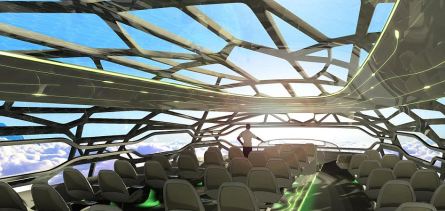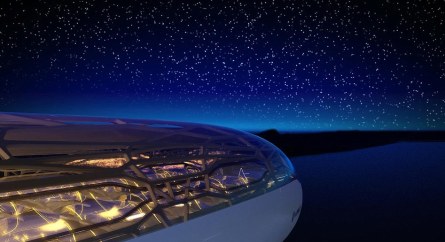Today's youth expect in the future to fly more often than they do today. They also want air travel to be inexpensive and enjoyable, and they want it to be green. Ask people what they want and the answer of course is "everything"; it is also no surprise to learn this from research by Airbus, a commercial operation that makes its money selling aircraft.
Like any good exercise in futurology, the Airbus vision of air travel in 2050 includes a wishlist of wonders and glosses over the detail of just how we are going to get there, or pay for it.
To view its 25min semi-animated film Future of Flight - produced for its debut showing on the planetarium dome at the Royal Observatory Greenwich - is to wonder if Airbus engineering chief Charles Champion and his team spent a bit too much of their youth watching early science fiction films.
Imagine an aircraft built of intelligent membranes that turn from opaque to transparent on command, to do away with windows and provide a panoramic view of the sky. Enhanced reality projection could add to the scene, or even turn it into an image of your destination or, say, your bedroom. Fanciful? Not in 2050; after palm-recognition check-in the aircraft knows who you are, and keeps track of you through the flight thanks to smart materials and neural networks that learn everything from your lighting preferences to the size of your posterior, adjusting ambience and seat shape accordingly.
 |
|---|
© Airbus |
Airbus's idea is that we can do away with traditional seating by class and build the cabin to give each passenger a tailored experience indistinguishable from life on the ground. Want to work? Turn your space into an office, or hire a private cabin and hold a teleconference. Rather play? Wander up to the "interactive zone" and enjoy a game of holographic golf, or maybe do some shopping in a virtual changing room.
Maybe travelling has worn you down? Take a seat in the "vitalising zone" and recharge your batteries with an infusion of vitamin-and antioxidant-enriched air, mood lighting, aromatherapy and acupressure treatments - while enjoying that panoramic look at the sky (assuming such a view at 30,000ft doesn't scare you half to death).
All of this recalls the introductory hype surrounding the Airbus A380. Airlines, we were told, would use all that double-decker space to transform travel with flying-palace wonders. True, Emirates first-class passengers can take a shower on board, and Singapore Airlines offers private cabins. There are a few flying cocktail lounges. But, more or less, airlines reacted in a predictable way by filling the aircraft with seats. Lots and lots of them. The main feature, not to be discounted, is fuel consumption of just 3 litres/100km/passenger.
But while much of the Airbus 2050 vision seems like engineers' daydreams, some of their technology concepts are not so far out and should come to market long before the halfway mark of this century.
Bionic-inspired structures that mimic birds' bones - strong where needed and light everywhere else - are already on the drawing board. Structures should also get lighter thanks to the additive layer manufacturing - so-called 3D printing - that is already providing Formula 1 cars with super-light structural parts.
 |
|---|
© Airbus |
Energy harvesting techniques to capture passengers' body heat to power onboard systems are already in use in the Stockholm metro; Champion reckons they are only a decade away for commercial aviation.
Hydrogen fuel cells will never power a jetliner, but could provide emission-free onboard electric power while on the ground. Solar panels on the wings and fuselage should be another way to provide some onboard power.
Not so far off, too, are self-repairing materials that keep the interior in as-new condition. Champion is also enthusiastic about prospects for doing away with non-renewable materials in the aircraft interior, in favour of fully recyclable plant fibres - even if he does confess that it is still pure dreaming to talk about engineering plants to grow to a custom shape.
But what really counts is to look beyond Airbus's musings on the sort of physical aircraft it could, perhaps, build. Champion's vision is of the aircraft as only one element in an integrated transport system capable of providing a seamless home or office to final destination experience. The goal, he says, "is a world where travel is a pleasure, not a time-waster".
That seamless experience - including a vastly improved air traffic management system capable of allowing aircraft to fly closer together and on straighter courses - should be much more efficient than today's grind through airport traffic jams and security followed by runway delays and holding patterns. There is only so much space on the ground at airports and in the sky above them, so if there is to be more air travel in future, there are going to have to be major strides in the sort of integrated efficiency Airbus is talking about.
Some of its traffic management ideas are plausible. With computer flight control and better air traffic management, large numbers of aircraft probably could travel in platoons, to safely increase the density of crowded flight paths.
Others seem far-fetched. Seating passengers in pre-loaded modules for packing into aircraft, like cargo containers, sounds structurally inefficient at best and carries more than a whiff of science fiction or theme park ride. Similarly, a notion of enormous "carrier aircraft" flying long-haul routes bearing passenger-laden regional transports seems like a step too far, however unpleasant it can be to change aircraft en route.
The merits or otherwise of any one of these concepts is not the point. The powerful idea behind Future of Flight is that if we do nothing, we will stumble into a future where the economic and cultural benefits air travel are lost to congestion and pollution. The alternative is to start, as a society, forming a vision of how we want the world to be, and how we are to get there.
To that end, Airbus has the opportunity to become a thought leader in the quest for a future of sustainable transport.
Source: Flight International























